How to Keep Geraniums from Getting Leggy: Simple Tips for Fuller Blooms
Are your geraniums starting to look a little spindly and stretched out? Sometimes, geraniums can become leggy, making them appear less vibrant and lush than you might like.
To keep your geraniums from getting leggy, you should prune them regularly and pinch back the stems. By removing the tips of new growth, you encourage the plant to develop more branches and produce a compact and bushy appearance.
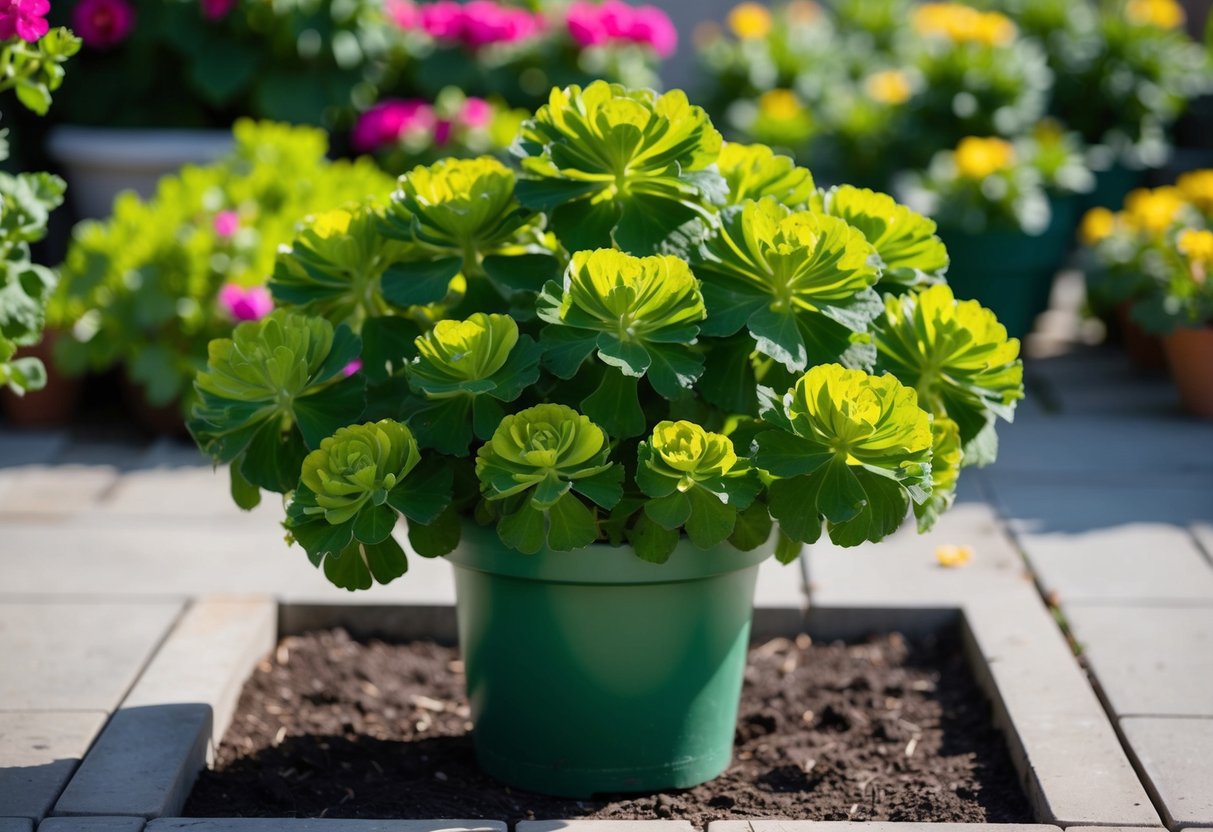
Another key to avoiding leggy geraniums is monitoring their sunlight exposure. Geraniums need plenty of sunlight, so placing them in bright locations ensures they have the energy required for healthy growth. If your geraniums aren’t receiving enough light, they might reach outward in search of more, leading to that unwanted leggy look.
To see your geraniums thrive, focus on regular care practices. Pruning, proper light, and not overly restricting their energy by cutting too many leaves all contribute to their healthy appearance. By paying attention to these elements, your geraniums will remain a beautiful addition to your indoor or outdoor garden.
Getting to Know Geraniums

Geraniums are known for their vibrant blooms and versatility. There are various types, each with unique characteristics. To keep them healthy and robust, you need to understand their specific growing needs, including light, water, and soil requirements.
Different Types of Geraniums
Geraniums, often confused with pelargoniums, are popular for their colorful flowers. True geraniums, or hardy geraniums, thrive in cooler climates and have a more delicate flower structure. They are versatile garden plants that can survive winter frost. Pelargoniums, on the other hand, are often seen in containers and need protection from cold. Knowing the difference between these types helps you choose the right plants for your garden, adapting with weather changes and regional climate needs. This ensures vibrant blooms through the year.
Optimal Growing Conditions
To ensure your geraniums stay compact and healthy, give them plenty of sunlight. These sun-loving plants need at least four to six hours of direct sunlight daily. Well-draining soil is essential to prevent root rot.
When watering, make sure the topsoil is dry before adding more water. This avoids overwatering and encourages strong root development. Regular pruning helps maintain shape and promotes bushy growth. Pinch new growth to encourage branching, particularly in pelargoniums, for a fuller look. By meeting these conditions, your geraniums will bloom beautifully and remain lush throughout their growing season.
Proper Watering Techniques
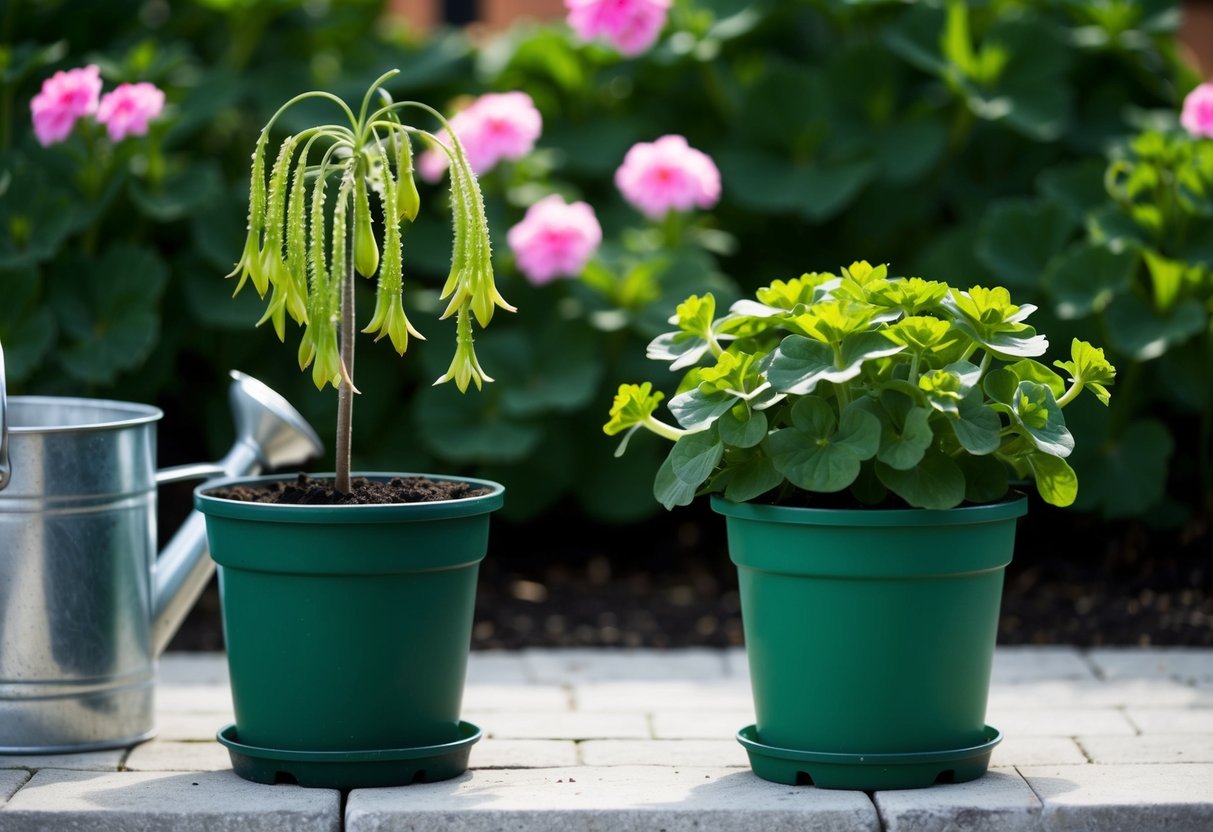
Keeping geraniums healthy and vibrant involves using specific watering techniques. It’s important to find the right balance to prevent issues like leggy growth or root rot. Understanding how to water correctly can make a big difference in plant care.
Watering Wisely
When watering geraniums, the timing and method are crucial. Always water them in the morning or evening. This helps prevent evaporation and keeps the soil from drying out too quickly.
Use about 0.5 liters of water per plant, making sure the soil is evenly moist.
It’s best to water directly onto the soil, not over the leaves or flowers. Wet leaves can lead to disease and other problems. Choose well-draining soil to help avoid waterlogging. Adding mulch can also keep the soil moist and reduce the frequency of watering, ensuring your plants stay healthy.
Dealing with Over- and Under-Watering
Finding the right balance in watering geraniums is essential. Over-watering can lead to root rot, while under-watering might cause stress and impede blooming.
Check the soil moisture by sticking your finger about an inch into the soil. If it feels dry, it’s time to water.
If overgrown geraniums are present, they may need more water to thrive. However, be cautious not to water too much. Adjust the amount based on pot size and plant needs. Install drainage holes if your pots tend to retain too much water. This will help control moisture levels and protect your plants from damage.
Pruning for Perfect Plants
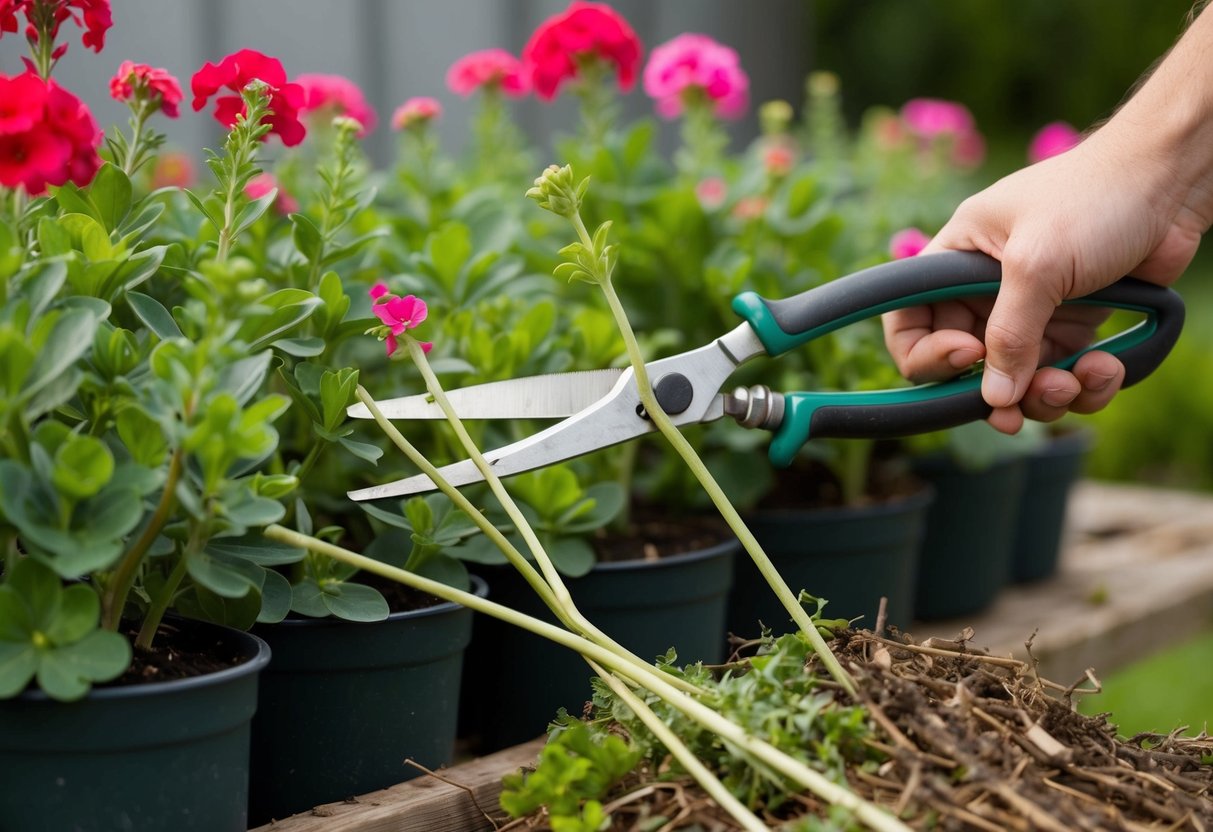
Keeping your geraniums looking their best involves regular pruning. By cutting back, you encourage bushier growth and help prevent legginess.
The Right Way to Prune
When pruning your geraniums, make sure to use clean, sharp tools. Begin by removing any dead or yellowing leaves, as these can hinder new growth and spread disease.
Focus on cutting back long, thin stems. To promote fullness, cut the stem just above a leaf node, which is where new branches can sprout. Don’t forget about deadheading, which involves snipping off spent blooms to encourage more flowers. Regular pruning helps maintain a healthy, dense plant structure. You can also pinch off the tips of new shoots, which stimulates bushier growth.
When to Cut Back
Timing is key when it comes to pruning geraniums. The best times to do this are in spring and summer, when the plants are actively growing.
Cutting back during these seasons encourages more robust growth. If your geraniums are indoors, consider pruning them in late fall before bringing them inside. This helps keep them tidy and prevents overgrowth. Avoid pruning in cold, inactive periods, as the plants may struggle to recover.
Make sure to trim in a well-lit area for better visibility and accuracy. Remember, regular pruning and maintenance can keep your geraniums healthy and beautiful all year round.
The Fertilizer Factor
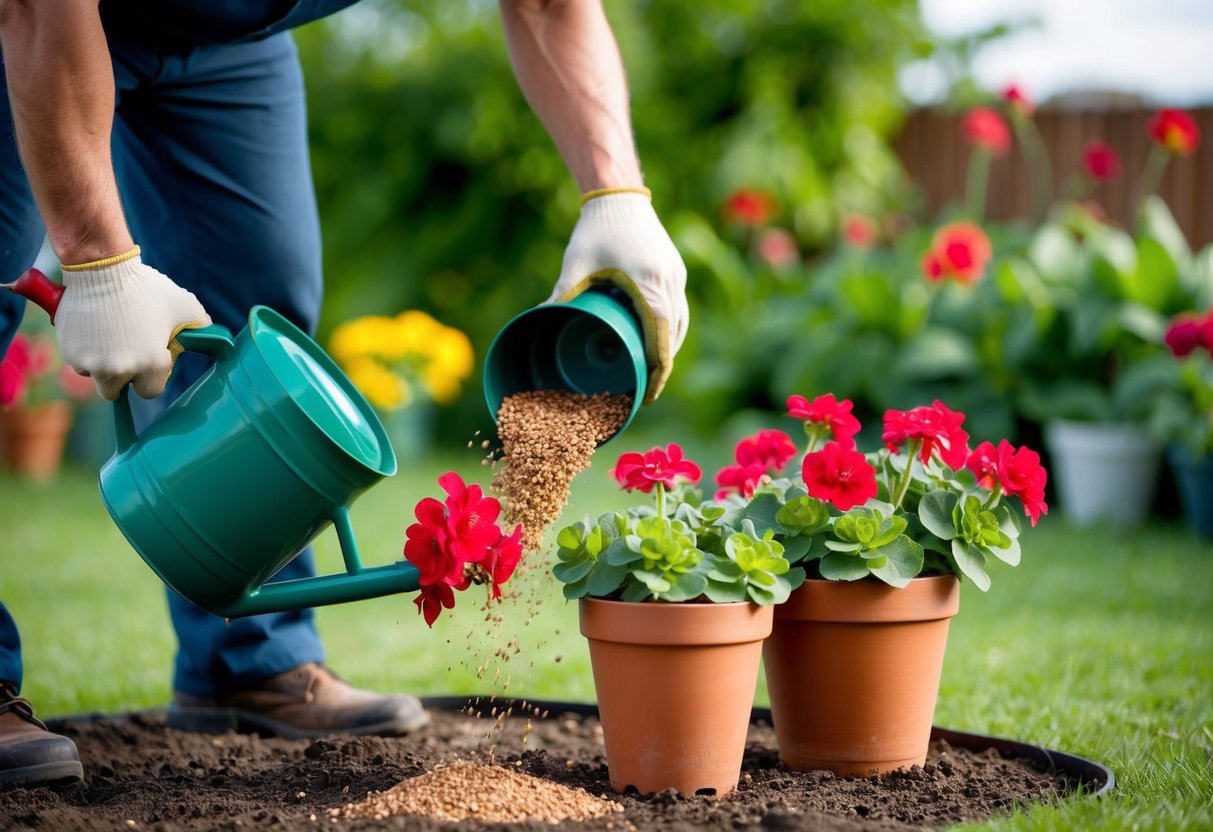
Geraniums need the right balance of nutrients to grow strong and avoid becoming leggy. With the right fertilizer, you can encourage vibrant blooms and healthy stems.
Choosing the Right Fertilizer
Selecting the best fertilizer involves understanding your geraniums’ needs. A balanced liquid fertilizer is often recommended, such as a 10-10-10 or 15-15-15 mix. These numbers indicate the ratio of nitrogen, phosphorous, and potassium. All these nutrients are important.
Nitrogen promotes healthy growth, while phosphorous supports flower production. Potassium helps with overall plant health and bloom time. If you prefer an eco-friendly approach, consider using an organic fertilizer. This type can offer a gentler release of nutrients, helping prevent over-fertilization.
Understanding Nutrients for Geraniums
In this section, it’s vital to know each nutrient’s role in geranium care. Nitrogen is essential for leaf and stem growth. Meanwhile, phosphorous aids in strong root and flower development.
Without enough phosphorous, your geraniums might have fewer flowers. Potassium contributes to disease resistance and enhances bloom quality.
Applying fertilizer every two weeks can keep your geraniums thriving. Be careful with the amount you use. Too much can lead to lush foliage with fewer blooms. Regular feeding supports both the growth and flower production of your geraniums, helping them stay bushy and vibrant throughout the season.
Troubleshooting Common Problems
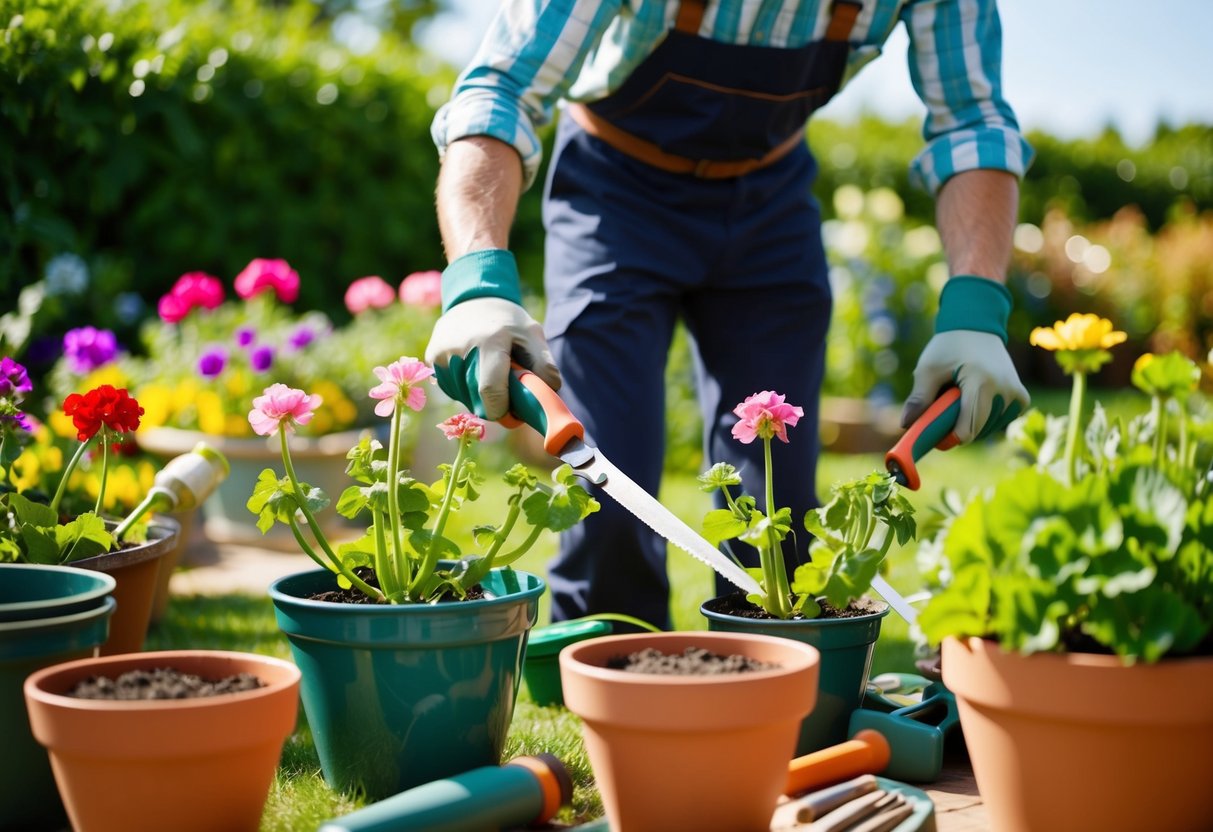
To keep your geraniums thriving, it’s important to understand pest prevention and how to revive dormant plants. These topics will help you maintain healthy geraniums and avoid common issues.
Pest and Disease Prevention
Keeping geraniums safe from pests and diseases is key to their health. Pests like aphids and spider mites can attack your plants.
Inspect your geraniums regularly to catch infestations early. Look for tiny insects on leaves or webbing, which are signs of spider mites.
Remove affected leaves and consider using insecticidal soap. Good air circulation is vital. Make sure your geraniums have space to breathe by not overcrowding them.
Diseases such as leaf spots can also harm your plants. Check for discolored patches and remove damaged parts to prevent spread. Always water from the base to keep the leaves dry, reducing the chance of fungal diseases.
Reviving Dormant Geraniums
If your geraniums enter a dormant phase, don’t worry. Dormancy is a natural rest period.
To revive them, start by trimming dead or yellowing leaves. Then, cut back the stems to encourage new growth.
Place your geraniums in a warm, sunny spot to wake them from dormancy.
Water when the soil is dry but don’t overwater as it might harm the roots.
Gradually, your plants should show signs of life. Patience is key.
Fertilize them lightly once new growth appears to give them a boost.
Proper geranium care can bring them back to vibrant life, ensuring a healthy regrowth cycle.







